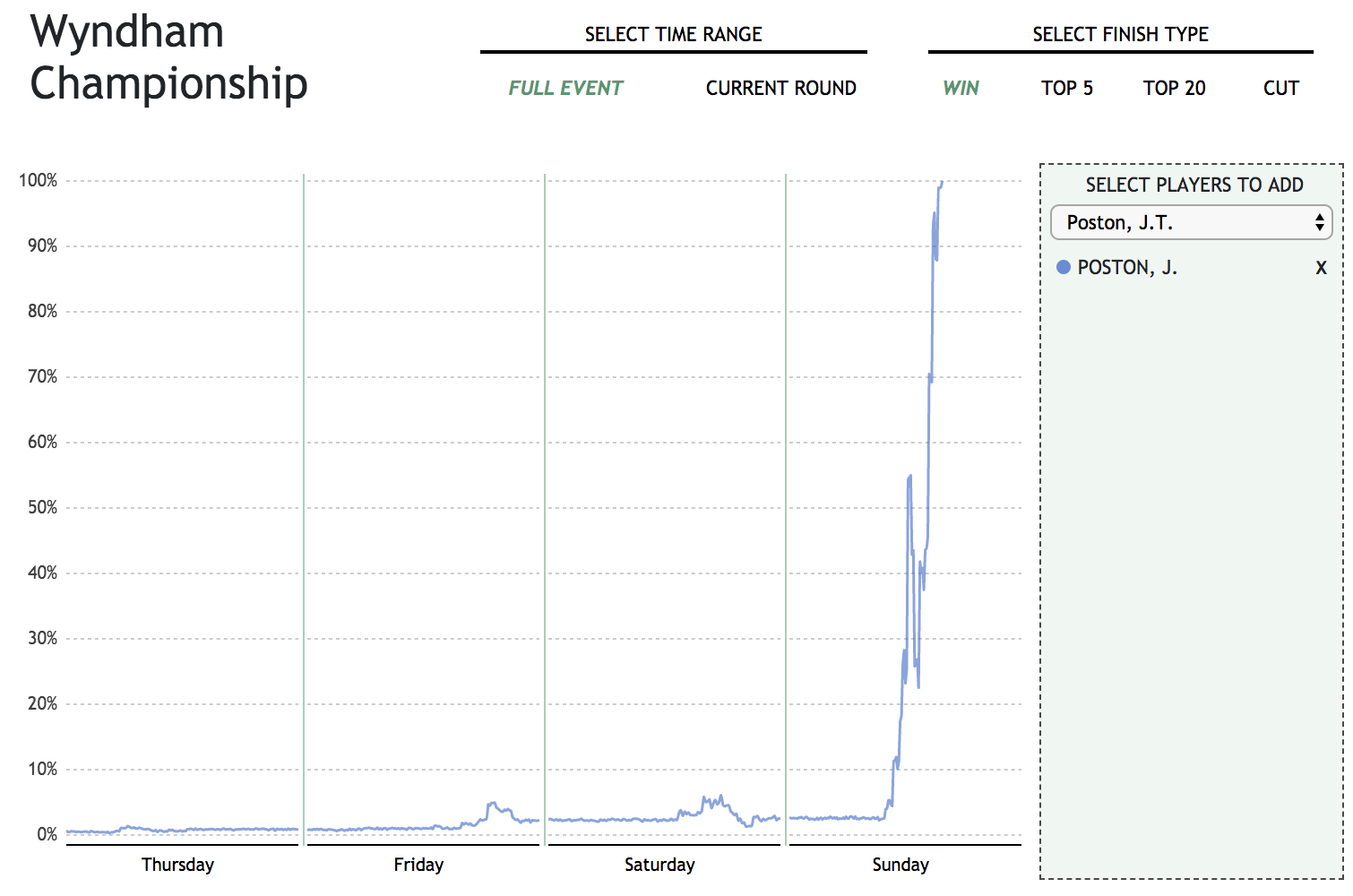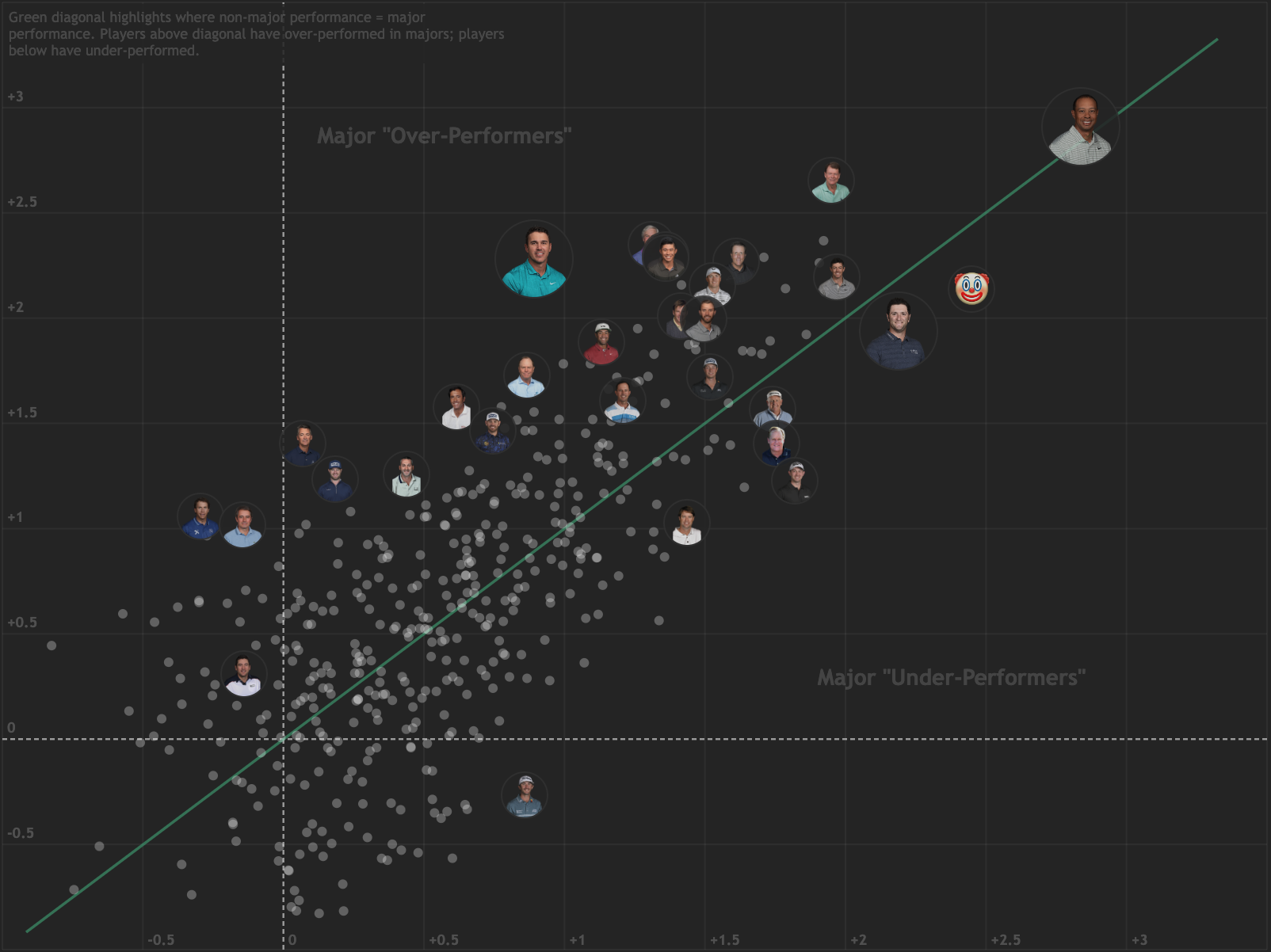
 I.T.N. No. 13
I.T.N. No. 13PUBLISHED August 5, 2019
Inside The Numbers ...
is a brief numerical summary of the current happenings in the world golf, published every Monday — hopefully.
35.6% WIN PROBABILITY
If you like to see underdogs succeed, professional golf does not disappoint.
At last week’s Wyndham Championship, there was a 35.6% chance a golfer who started the event
with a win probability of less than 1% would go on to win. The eventual winner, J.T. Poston,
was one of those golfers, as our model assigned him a pre-tournament win probability of just 0.5%.
In fact, Poston’s win probability got as low as 0.3% after starting his week with 3 straight pars, and
was still just 2.5% at the beginning of Sunday's final round:
Is it concerning that a player who at one point had just a 0.3% win probability according to our model,
went on to win?
Not really,
simply due to the fact that there are so many golfers with very
low win probabilities at some point during a given week, that we should expect some of them
to actually go on to win once in a while (hopefully,
about 0.3% of them.)
+0.45 STROKES-GAINED
The eye test certainly supports the widely held belief that distance is king in today’s game:
quickly scan the DG Rankings
and it is evident that most of the top players hit the ball a long way.
But what does the data say? Our early analysis — with a full blog post to come in the near future — also agrees with this idea.
From 2004 to 2011, the 25 longest hitters each year on the PGA Tour gained an average of 0.25 strokes per
round (adjusted for field strength). Compare this to the top 25 long ballers from 2012 to 2018, who gained
0.7 strokes per round, and we see a difference of 0.45 strokes per round between bombers' performance in the two eras. A common
explanation for this observation is that distance has increased to the point where the
longest hitters can simply "overpower" a golf course (whatever that means). A more measured
approach requires looking at why the longest hitters are gaining more strokes
than they were 10-15 years ago. For example, it’s possible the high level of play
we see from long hitters today is in part because they are also better iron players than their predecessors.
Stay tuned for the full analysis in the next couple weeks!
2 PLAYERS
Webb Simpson has been very solid in 2019,
averaging +2.11 true strokes-gained on the season
(recall that a top 5 player in the world typically averages +2 true SG for the year).
Simpson has played especially well of late,
and as a result has vaulted all the way up to 3rd in the Data Golf Rankings,
trailing just 2 players. While it seems absurd
to label Webb Simpson as the 3rd best player in the world, our method for
arriving at this conclusion is transparent: Simpson has the 3rd highest true strokes-gained
average over the time horizon we consider. When it comes to actually forming predictions,
however, Simpson is just our model’s 6th highest rated player. The difference, as followers of our
website will know, is due to the fact that a
significant part of Simpson’s recent performance has been
driven by putting,
which is less predictive than other parts of the game.
126th FEDEXCUP RANK
An irritating group member once proclaimed ‘golf is a cruel game’ after watching one of our
playing partners yip a 15 inch putt. While the timing of the remark was less than ideal,
its content was spot on. Never is this saying more true than in the final week of
the PGA Tour regular season. This year, Richy Werenski drew the short straw and ended up 126th
in the FedexCup standings. Adding insult to injury is the fact that Werenski
actually played better
this year (averaging -0.01 true strokes gained) than he did in 2018 (averaging -0.21 true strokes gained) when
he finished inside of the top 125 mark. In addition to being cruel, professional golf can also be unjust.
Richy will have to regroup and try to regain full status through the Korn Ferry Tour Finals.
I.T.N. ARCHIVE
RECOMMENDED BLOGS
Recent Blog Posts
Model Talk Blog
Does our model overvalue leaders?

 Data Visualization Blog
Data Visualization Blog
Skill Distribution of Major Champions








